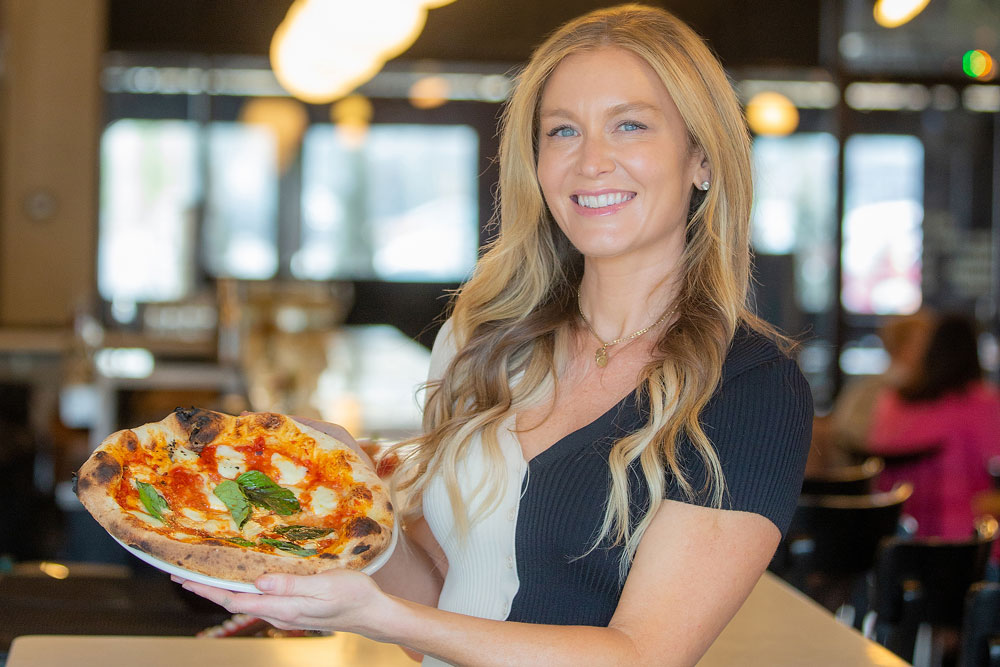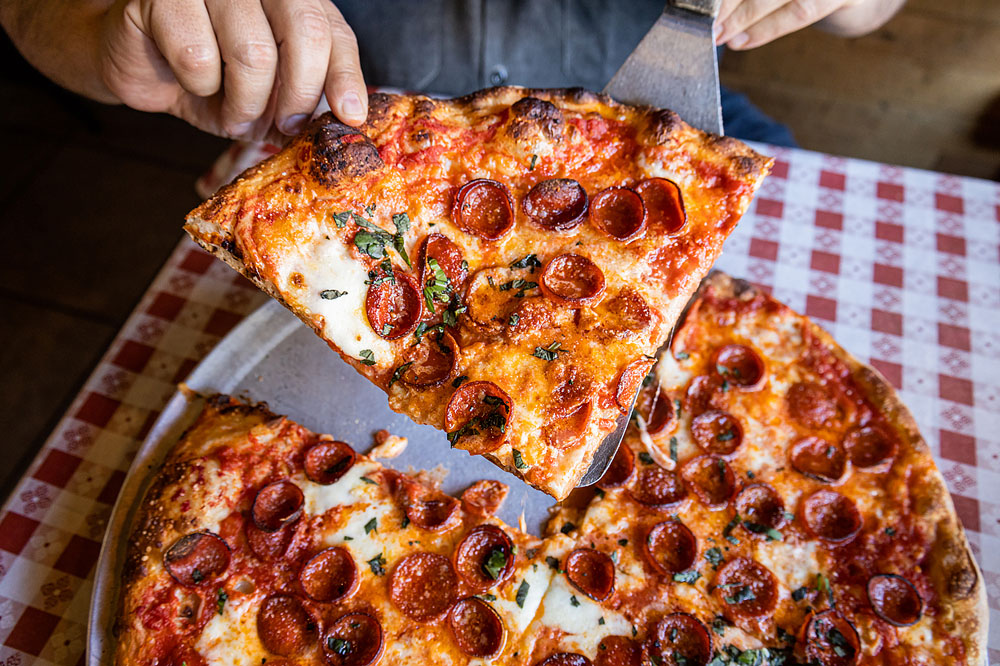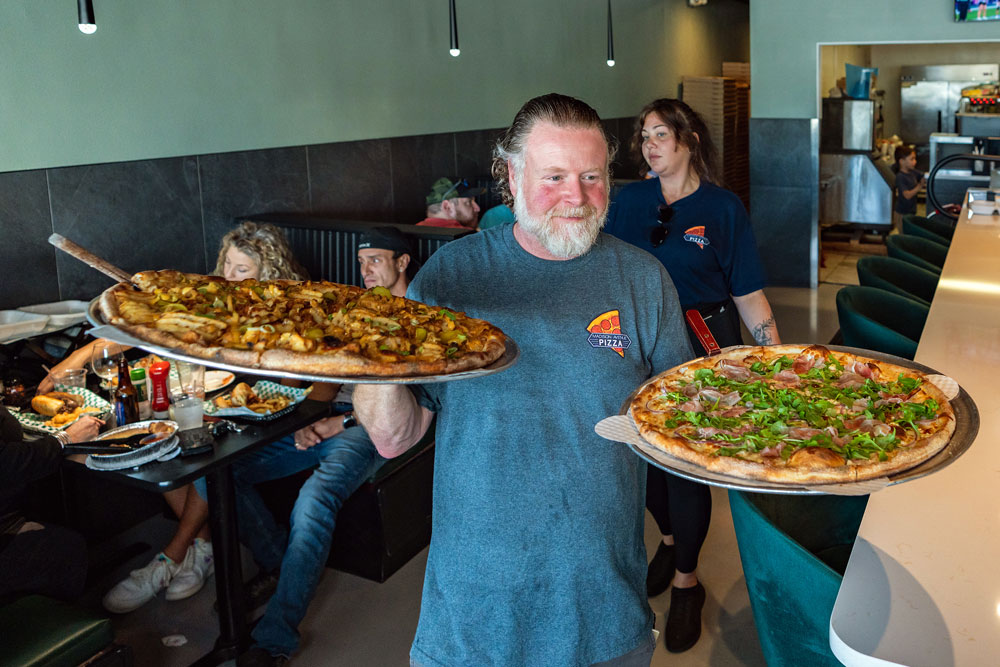By Rick Hynum
For decades now, Americans have been told that pizza is an unhealthy food. Bread and cheese and meat, begone! Healthy eating means broccoli, beets and Brussels sprouts! Save the pizza for birthdays and Super Bowls, and you’ll live longer—or so the story goes. But you’ll be hard-pressed to find a nutritionist or dietitian who agrees. In fact, the opposite is true. And it’s time we started sharing the facts with our customers: They don’t have to feel bad about the food that makes them feel so good.
“When you use real food and cook from scratch, the health benefits are tremendous,” says Katie Collier, owner of Katie’s Pizza & Pasta Osteria in St. Louis. “This is the philosophy in Italy. This is what I learned while living there. It’s not about carbs or wheat; it’s about real food, no added sugar and beautiful, healthy oils. This is why you can go to Italy and eat a ton of pasta and not gain weight.”
Sean Ferraro, owner/chef of Madison Avenue Pizza in Dunedin, Florida, agrees. “I often remind my customers that, unlike most foods, the ingredients that go into our pizza have no preservatives or ingredients that you can’t pronounce, and they’re minimally processed,” Ferraro says. “Our dough, like most doughs, is made with flour, spring water, salt, sugar, olive oil and yeast. Our sauce is just whole ground tomatoes with a little sea salt and some herbs. They are minimally processed and straightforward.”
So why do so many people think eating pizza will pack on the pounds? Maybe because it’s the go-to meal for a good time, Ferraro suggests. “I think pizza gets a bad rap because it can be the quintessential ‘binge’ food for people that are watching a football game, filling their stomachs after a night out drinking, or numerous other times when healthy eating isn’t a concern. But pizza isn’t just for binge eating, especially with the modern pizza movement that focuses on fresh, local and high-quality ingredients.”

Katie Collier / Katie’s Pizza and Pasta Osteria
The “All Foods Fit” Philosophy
Collier, who plans to open her third store this year, has gotten positive feedback about her food from customers with diabetes. “Our pizzas and pastas don’t spike their blood sugar, and it’s the same with gluten-intolerant customers,” she says. “They don’t have as many reactions.” That’s no surprise to Collier, who also grows herbs for her dishes—basil, oregano, mint, rosemary, tarragon, etc.—in patio gardens at every store. “When you use very fresh, organic ingredients and make food from scratch without processing, you eliminate a lot of the harm that we’re seeing from our overprocessed foods today. We don’t cook with any sugar. We use local, fresh-milled, organic semolina and durum flour. We use only extra-virgin olive oils. All of our produce is organic and local.”
“When you use real food and cook from scratch, the health benefits are tremendous. This is the philosophy in Italy.”
— Katie Collier, Katie’s Pizza & Pasta Osteria
Granted, not every pizzeria owner is that choosy about ingredients. For some, it’s all about cheap and fast. But, unlike a Big Mac, cheap and fast doesn’t necessarily signify “unhealthy” in pizza making. Most pizzas have some key ingredients in common. And, according to nutrition experts, those ingredients, eaten in moderation, are good for the body.
Related: Tom “The Dough Doctor” Lehmann explains why pizza is good for you
Just ask Lindsay Wengler, a registered dietitian at Olive Branch Nutrition in New York City. She specializes in nutrition therapy for clients seeking freedom from dieting or dealing with eating disorders—aiming to help clients “make peace with food,” according to her website. “I spend a lot of time with my clients discussing the nutrition philosophy of ‘all foods fit,’ and that there are no ‘good’ or ‘bad’ foods,” Wengler says.
“Some foods get a bad rap as being ‘unhealthy’ or ‘bad,’ yet we overlook the simple fact that each food provides some type of nutritional, cultural or social component that shouldn’t be ignored,” she adds. “When we start to break down pizza for what it really is—dough/bread, tomatoes, cheese and olive oil—we can see how it doesn’t deserve the stigma. When we analyze those ingredients even further, we can see the nutrition and health benefits that pizza actually provides.”

Lindsay Wengler enjoys authentic Italian pizza at Gino Sorbillo in Naples. Courtesy Lindsay Wengler
The Nutrition Proposition
So let’s take a closer look at the ingredients that make pizza so delicious and nutritious, starting with the crust.
“Pizza dough, crafted with an incredible combination of art and science, is fermented, which tends to make it easily digestible,” Wengler says. “The fermentation process digests some of the carbohydrates in the dough, which produces carbon dioxide—that’s how we get those beautiful air bubbles in pizza crust. The complex carbohydrates found in pizza dough provide our cells with energy and, depending on the type of flour used, it can also contain important B vitamins: thiamine, niacin and riboflavin, which are key nutrients in energy production.”
Brittany Lubeck, a Fort Collins, Colorado-based registered dietitian and consultant for Oh So Spotless, adds that tomato sauce is also packed with nutrients. “One of these nutrients is lycopene, an antioxidant linked to prostate cancer prevention,” she says. “Interestingly, lycopene is found in higher amounts in tomato sauce and canned tomatoes than in fresh tomatoes, giving you all the more reason to enjoy a classic slice of pizza.”
According to the New York City-based Memorial Sloan Kettering Cancer Center’s website, lycopene-rich diets are also “generally associated with a decreased risk” of both heart disease and macular degeneration, which can cause worsening of vision.
“I spend a lot of time with my clients discussing the nutrition philosophy of ‘all foods fit,’ and that there are no ‘good’ or ‘bad’ foods.
— Lindsay Wengler, Olive Branch Nutrition
What about mozzarella? Wengler says it’s “an incredible source of protein, calcium, phosphorus and potassium, all of which contribute to bone health and strength.”
Related: Katie Collier: The queen of all pizza media in St. Louis
There’s no denying mozzarella boasts its share of saturated fats, but not as much as many other cheeses. And some fats are our friends. So chalk one up for the olive oil in your pizza dough. “Olive oil is an incredible source of monounsaturated fats (MUFAs), which have been shown to improve heart health and stabilize blood glucose,” Wengler explains. “Olive oil is also rich in phenols and vitamin E, which have powerful antioxidant and anti-inflammatory properties.”
Any healthy meal needs to be nutritionally balanced, Lubeck says, and pizza meets the criteria. “It contains the three macronutrients your body needs daily: carbohydrates, fat and protein. And when you add in veggies and other toppings, you also get essential micronutrients, including vitamins and minerals. Of course, there is a difference between an extra-thick-crust, triple-cheese pepperoni pizza and a thin-crust veggie pizza, but that goes without saying.”

Courtesy Mortadella Head
Making Pizza Even Healthier
True, if you pile on too many rich toppings, pizza becomes decidedly less healthful, says Mary Wirtz, a certified sports dietitian and consultant for Mom Loves Best. “Excessive amounts of cheese and processed meats—Canadian bacon, pepperoni and sausage—will not only drive up the saturated fat content of the dish but also the sodium. If some of these toppings are your absolute favorite, I encourage smaller (but flavorful) portions of these toppings.”
Then, again, the human body needs protein, too, as Lubeck mentioned, and meat toppings provide that in spades. And since chicken has become an increasingly popular topping, health-conscious customers can still have their meat pizza and eat it, too.
Vegetarian and vegan pizzas are another hot menu item these days, and there’s no denying their health benefits. “Adding more fresh veggies to your pizza will increase satiety, making you feel satisfied with fewer slices,” notes Eva De Angelis, a dietitian/nutritionist in Buenos Aires, Argentina, and writer for HealthCanal. “Vegetables are also naturally low in calories and fat while being high in bioactive compounds with numerous health benefits.”
“One of the keys to healthy pizza is long fermentation. It turns out that how you make the dough determines how you feel.”
— Chuck Sillari, Mortadella Head
Gluten-sensitive customers and those with celiac disease also need not avoid pizza these days, thanks to the proliferation of gluten-free options. Additionally, Chuck Sillari, founder/chef of Mortadella Head in Somerville, Massachusetts, believes the right dough making process can help with gluten sensitivity.
“One of the keys to healthy pizza is long fermentation,” Sillari says. “It turns out that how you make the dough determines how you feel. Bread and pizza are known to make people feel a little bloated and full. For someone with a gluten allergy or sensitivity, it can be pretty bad. Studies have shown that a lot of these gluten sensitivities are caused by the fast industrial baking processes being used. When flour gets mixed into dough and is baked off right away, it doesn’t have time to ferment properly, and the gluten proteins don’t have time to get broken down.”
Related: How to create moneymaking salads at your pizza shop
Gliadin, a protein that makes up gluten when it’s mixed with water, is “usually the issue,” Sillari says. “For some reason, a lot of people have a hard time digesting the gliadin. That causes the immune system to attack the inner lining of the small intestine, which can cause bloating and discomfort, and the lining of the intestines become inflamed. This inflammation doesn’t let your body absorb nutrients from the food like it should, which can cause discomfort.”
A longer dough fermentation period breaks down the gluten proteins before they ever enter the body. “According to a study done at the University of Copenhagen in 2016, gluten degradation starts to occur at around 24 hours,” Sillari notes. “And the longer it ferments, the more the gluten breaks down. I make Roman pizza al taglio dough and let it ferment for 72 hours. A lot of gluten is being broken down during that time. This is going to be a relief to your stomach. A lot of my customers who normally have trouble eating pizza tell me that ours doesn’t bother them.”

Courtesy Madison Avenue Pizza
Soul Food
As a pizzeria owner, you know what your customers want, and you’re under no moral obligation to make them eat healthier. But you can still educate them on the nutritional value of pizza and help them choose healthier items if they so desire.
“We believe health is personal, and so is the definition of ‘healthy,’” says Lisa Dimson, chief marketing officer for Your Pie, headquartered in Atlanta. “We provide options that fit every diner’s unique needs. Whether someone is looking for gluten-free, high-protein, keto or low-fat ingredients, we want to make sure everyone is able to create and enjoy a pizza that fits their lifestyle.”
Your Pie’s website offers a nutrition calculator for every order, from calories and total fat to fiber, protein and sodium. “Our top priority is to provide a menu that caters to our customers’ specific needs, so we asked them for their feedback,” Dimson says. “We learned that sharing nutrition facts helps people make choices that best fit their unique lifestyles, which, in turn, helps us ensure that our guest experience is top-notch—and it doesn’t hurt our bottom line, either.”
“Eating pizza can have a positive effect on your mental well-being by comforting the soul and providing feelings of satisfaction.”
— Jessie Hulsey, registered dietitian
Even if you don’t offer a nutrition calculator on your website, you can still position your pizza as a healthy food choice through social media marketing and your website. You can also highlight “good-for-you” pizzas on your menu, both online and on paper. Include information from this article—the cancer-fighting potential of lycopene, for example, or the body-fueling power of carbs—in your social posts and/or in a dedicated section of your website. Create YouTube videos or Reels about your dough fermentation process or the vitamins and fiber packed in your veggie pies.
And remind customers that pizza is good for the soul, too. According to Jessie Hulsey, a registered dietitian and consultant for Nutritious Lifestyles in Atlanta, pizza offers “mental health benefits that shouldn’t be discounted. Eating pizza can have a positive effect on your mental well-being by comforting the soul and providing feelings of satisfaction. It also stimulates dopamine production, which helps a person feel relaxed and at ease.”
Giving up pizza can have the opposite effect, Hulsey adds. “All in all,” she says, “while it’s important to watch your portion sizes when indulging in this delicious treat, there’s no doubt that having a slice or two of your favorite pie can do wonders for your mental health!”
Rick Hynum is PMQ’s editor in chief.















